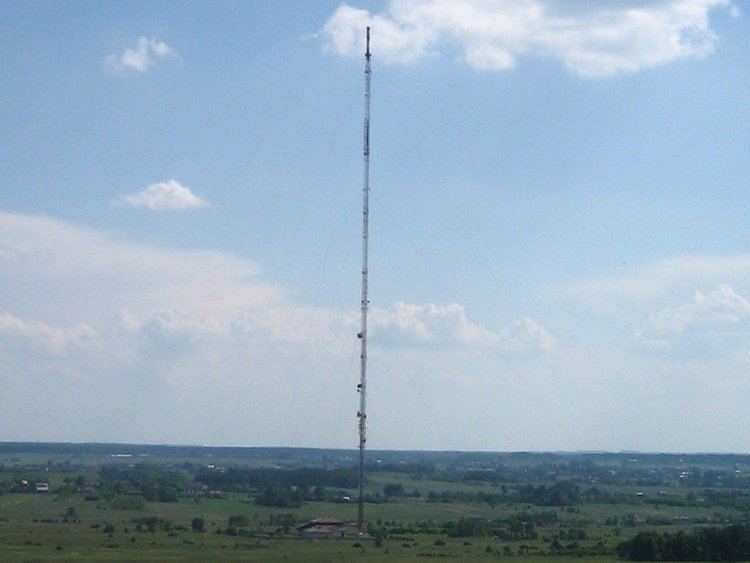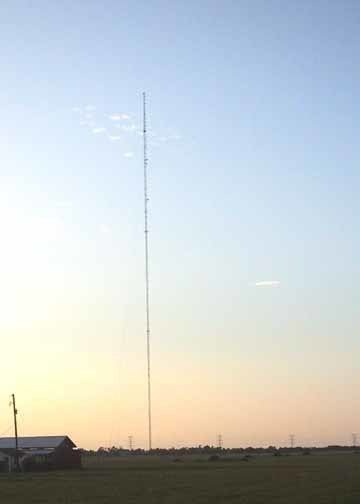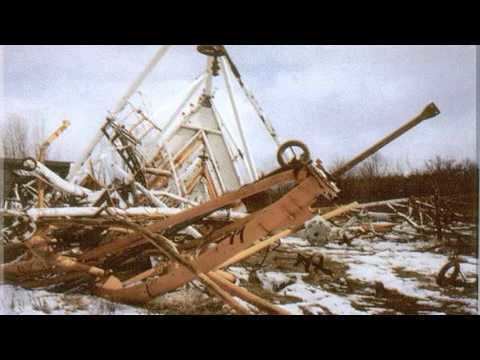Status Collapsed Height 646 m Opened 18 May 1974 Construction started July 1970 | Completed 18 May 1974 Destruction date 8 August 1991 Destroyed by Structural failure | |
 | ||
Type Mast radiator insulated against ground Other designers Alimak of Sweden (elevator)Brown & Boveri of Switzerland (transmitters)Several Polish companies Similar Abraj Al Bait, KRDK TV mast, Burj Khalifa | ||
The warsaw radio mast was the world s tallest structure 646 m 2120 ft
The Warsaw Radio Mast was the world's tallest structure from 1974 until its collapse on 8 August 1991. It is the second tallest structure ever built, being surpassed as tallest by the Burj Khalifa, completed in 2010.
Contents
- The warsaw radio mast was the world s tallest structure 646 m 2120 ft
- Construction
- Collapse
- Replacement
- Current state
- Replicas
- References

The mast, which was designed by Jan Polak, was 646.38 metres (2,120.7 ft) tall. Its construction, started in July 1970, was completed on 18 May 1974, and its transmitter entered regular service on 22 July of that year. It was located in Konstantynów, Gąbin, Poland, and was used by Warsaw Radio-Television (Centrum Radiowo-Telewizyjne) for longwave radio broadcasting on a frequency of AM-LW (long wave) 227 kHz before 1 February 1988 and AM-LW (long wave) 225 kHz afterwards. Its base was 115.2 metres (378 ft) above sea level. Because a voltage potential of 120 kV existed between the mast and ground, it stood on a 2 metres (6.6 feet)-high insulator. It operated as a mast radiator (half-wave radiator), so its height was chosen in order to function as a half-wavelength antenna at its broadcasting frequency. The signals from its 2 megawatt transmitters could be received across essentially the entire globe. Its weight was debated: Polish sources claimed 420 tonnes (930,000 lb).

Construction

The Warsaw radio mast was a guyed steel lattice mast of equilateral triangular cross section, with a face width of 4.8 metres (16 ft). The vertical steel tubes forming the vertices of the mast had a diameter of 245 millimetres (10 in); the thickness of the walls of these tubes varied between 8 and 34 mm (0.31 to 1.33 in) depending on height. The mast consisted of 86 elements, each of which had a length of 7.5 metres (25 ft). The mast had 3 arrays of guy wires, each attached to the mast at 5 levels: 121.78 metres (399.5 ft), 256.78 metres (842.5 ft), 369.28 metres (1,211.5 ft), 481.78 metres (1,580.6 ft), and 594.28 metres (1,949.7 ft) above ground.] Each guy was fixed on a separate anchor block at the ground and was 50 millimetres (2.0 in)) in diameter. To prevent the guy wires from interfering with the radio transmissions, the guys were insulated at regular intervals. The weight of guys and insulators.used to anchor the mast was 80 metric tons (180,000 lb). An elevator and separate protected ladders were installed in the interior of the mast to facilitate access to the various mast components, including the aircraft warning lamps. The elevator had a maximum speed of 0.35 metres per second (1.1 ft/s) and required 30 minutes for a trip from the bottom of the structure to the top.

In the lower half of the mast, there was a vertical steel tube, attached to the mast's outer structure with large insulators. This tube was grounded at the bottom, and connected electrically to the mast structure by an adjustable metal bar at a height of 328.68 metres (1,078.3 ft) when the tower transmitted on 227 kHz longwave and at a height of 334.18 metres (1,096.4 ft) when it switched to 225 kHz on February 1, 1988. This technique allowed adjusting the impedance of the mast for the transmitter and worked by applying a DC ground at a point of low radio frequency voltage, to conduct static charge to ground without diminishing the radio energy. Static electrical charge can build up to high values, even at times of no thunderstorm activity, when such tall structures are insulated from ground. Use of this technique provides better lightning protection than using just a spark gap at the mast base, as it is standard at most mast radiators insulated against ground.

The mast was equipped in 16 levels with air traffic warning lights with 200 watts power. Their height above ground was 49.18 metres (161.4 ft), 94.18 metres (309.0 ft), 121.78 metres (399.5 ft), 161.68 metres (530.4 ft), 206.68 metres (678.1 ft), 256.78 metres (842.5 ft), 296.68 metres (973.4 ft), 341.68 metres (1,121.0 ft), 369.28 metres (1,211.5 ft), 409.18 metres (1,342.5 ft), 454.18 metres (1,490.1 ft), 481.78 metres (1,580.6 ft), 521.68 metres (1,711.5 ft), 566.68 metres (1,859.2 ft), 594.28 metres (1,949.7 ft), and 634.18 metres (2,080.6 ft). At the top there was a flashing beacon consisting of two lamps with 1000 watts power.
A special overhead radio frequency transmission line was used to transfer the signal from the transmitter building to the mast. The transmitter building, situated at 52°22′22.9″N 19°48′25″E, had a volume of 17,000 cubic metres (600,000 cu ft) and was approximately 600 metres (2,000 ft) from the mast. The transmitter consisted of two 1,000 kilowatt units built by Brown Boveri and Cie. An atomic clock was used to generate the transmission frequency in order to provide a very accurate, stable signal source which could be used as a frequency standard by anyone within signal range. The station, which had an area of 65 hectares, also had a 76 metres (249 ft) lattice tower of rectangular cross-section close to the transmitter building, at 52°22′23.6″N 19°48′24.4″E. This tower was used to provide a radio link for programme feeds from the studio, which ran from the Palace of Culture and Science, Warsaw via a radio relay tower at Wiejca.
To supply power to the station a 110 kV substation was built. The substation was over-engineered due to the strategic importance of the station as Poland's central transmitter. Although the power consumption of the transmitting station was large (estimated 6,000 kW), the substation was capable of supplying much more than was required.
Six small towers were erected around the periphery of the station's grounds in order to support aircraft warning lamps where the guy ropes were located. They are situated at 52°22′17.4″N 19°48′9.7″E, 52°21′53.8″N 19°48′6.3″E, 52°21′57.1″N 19°47′48″E, 52°21′55.8″N 19°48′27.6″E, 52°22′6.1″N 19°48′24.3″E, and 52°22′8.1″N 19°47′54.4″E.
The official name of the facility was Radiofoniczny Ośrodek Nadawczy w Konstantynowie (Radiophonic Transmission Center Konstantynow), Radiowe Centrum Nadawcze w Konstantynowie (Radio Transmission Center Konstantynow) or Warszawska Radiostacja Centralna (WRC) w Gąbinie (Warsaw Central Radio Station Gabin). It broadcast Polskie Radio's Program I.
Approximately ten years after completion of the mast, inspections revealed structural damage caused by wind-induced oscillations at the mast, the backstage insulators and the guys. Repair work was very difficult and replacement of the mast by a stronger construction of the same height was considered. This was not realized, as a result of Poland's economic situation. In 1988 the mast was repainted, but this could not be done to the desired extent, as there was not enough paint available.
Collapse
On 8 August 1991 at 16:00 UTC a catastrophic failure led to the collapse of the mast. The mast first bent and then snapped at roughly half its height. The helix building and the transmitter building (including the transmitter devices in it) were not damaged. The construction coordinator and the division chief of the company which built and maintained the mast were found liable for the collapse, and both were sentenced to two years in prison.
Since the collapse of the Warsaw radio mast, the tallest structure in Poland has been the FM radio and TV transmission mast at Olsztyn-Pieczewo, measuring 360 metres.
Replacement
After the collapse of the radio mast at Konstantynów, the Polish broadcasting company used the old Raszyn transmitter with its 335 metres (1,099 ft) mast near Warsaw, which had been used since 1978 for daytime transmissions of a second Polish broadcasting service programme in the longwave range on the frequency AM-LW 198 kHz, for transmissions on AM-LW 225 kHz with a power of 500 kilowatts. It is not possible to transmit from Raszyn on AM-LW (long wave) 198 kHz/1515 meters and 225 kHz/1333 meters simultaneously, so the transmissions on the second longwave frequency AM-LW (long wave) 198 kHz had to be discontinued until either a second longwave broadcasting transmitting facility was built in Poland or a special frequency switch, which would allow transmissions on both frequencies, was installed at the Raszyn transmitter. The latter, simpler solution would have decreased the effectiveness and reliability of both transmitters and was therefore found unacceptable.
Because the Polish longwave transmitters are of special importance to Polish people abroad, as early as April 1992 the Polish government planned to rebuild the mast at Konstantynów. In September 1995 the Polish government was set to rebuild the mast. Although refurbishment of the old basements, which could be reused, had already started, the rebuilding of the mast was cancelled due to protests by local residents, who claimed that radiation from the mast was a health hazard. While the accuracy of these claims has not been verified, a new site for the transmitter was sought. Several other locations were considered, but due to the continuing resistance of nearby inhabitants (backed by the Solidarity trade union), planned mast height and transmitter range were both greatly reduced, and an old military site just southeast of Solec Kujawski was chosen. There, a new longwave transmission facility was built in 1998-99, with a transmitter of 1200 kW output power for the frequency AM-LW (long wave) 225 kHz. This facility, which was inaugurated on September 4, 1999, uses one 330 metre (1083 ft) and one 289 metre (948 ft) grounded upfeed masts as aerials.
After the inauguration of the transmitter at Solec Kujawski, the transmitter at Raszyn was again used for transmitting on the frequency AM-LW (long wave) 198 kHz for the programme Radio Parliament.
Current state
Except for the mast and the radio frequency transmission line that led to it, nearly all components of the facility remain in place, unused and slowly deteriorating.
Replicas
Eldorado do Sul RBS Radio Mast, a mast radiator in Eldorado do Sul, Brazil, is a nearly perfect replica of Warsaw Radio Mast with 35.5% of its height.
